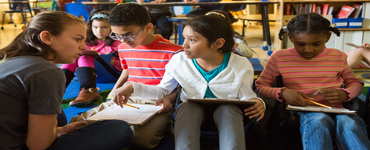Most English learner (EL) teachers’ practice already aligns with many aspects of reading instructions supported by the science of reading. An informed view of the science of reading can help EL teachers better understand how their own existing practice may fit into the science of reading framework.
Keywords: the science of reading, reading instruction for ELs, literacy education
Introduction
Minnesota joined the growing number of states and school districts across the nation when its governor signed into law, in 2023, that all students in Minnesota be taught how to read based on the science of reading approach. The Minnesota Department of Education (MDE) has made resources and professional training programs available for teachers and educational administrators in Minnesota. At the same time, as clearly described in Dudley (2023) in this very journal, the implementation of the science of reading approach can still become a contentious issue with implications for selecting the reading curriculum, training teachers, and adapting to a new belief about teaching how to read.
Another issue that deserves critical attention, in any discussion about literacy education based on the science of reading, is the common misunderstanding that the science of reading is only or all about phonics (the teaching of the letter-sound relationships). Such misguided views can be informally observed in conversations among teachers at professional conferences such as the Minnesota English Learner Education (MELEd) conference. Such an informal observation is also supported by a sampling of the titles of mainstream news media articles covering the science of reading such as “In Memphis, the phonics movement comes to high school” (Mervosh, 2023) and “In a seismic shift, NYC to mandate elementary schools use phonics-based curriculum” (Zimmer et al., 2022). In these news articles, the change being discussed is more broadly about literacy education based on the science of reading. As identified by the National Reading Panel (2000) based on a large body of scientific research on reading, phonics is only one of the five pillars of reading instruction: phonemic awareness, phonics, fluency, vocabulary, and comprehension.
Several of these pillars overlap with most of what English learner (EL) teachers do in their teaching such as teaching pronunciation, teaching vocabulary, or teaching spoken language comprehension. It is important to recognize this accurately to avoid the potential misinterpretation of what needs to change in their current practice to align with the new requirements in literacy education. Therefore, this article aims to help connect EL teachers’ current knowledge and practice with the framework based on the science of reading with a special emphasis on the role of implicit vs. explicit teaching and learning.
What is in the foundation of fluent reading?
To put it simply, the foundation of fluent reading is built with readers’ automaticity in “being able to look at written words in text and recognize their pronunciations and meanings immediately” (Ehri, 2022, p. 53). Fluent readers’ automaticity in recognizing written words is well demonstrated in modified versions of what is known as the Stroop task (Stroop, 1935/1992). To perform the task successfully, participants are supposed to suppress one kind of visual cue. For example, participants may see different shapes in different colors (Figure 1a) or different words presented in different colors (Figure 1b).
 |
 |
In a self-paced reaction time task, in which both speed and accuracy are important, most people perform naming the color of each shape rapidly and accurately. However, when the visual stimuli are written words, participants’ reaction slows down or their accuracy is reduced because they end up reading the word although the task is naming the color in which the word is presented. In other words, participants say GREEN more quickly when they see a green square (Figure 1a) than they do when they see the word RED shown in green (Figure 1b). Participants often end up saying RED (reading aloud the written word) instead of saying GREEN (naming its color). The Stroop task displays the nature of true automaticity in recognizing written words. When a mental procedure has reached a high-level of automaticity, it becomes difficult to suppress. Children as young as at the end of their first grade show evidence of automaticity in recognizing written words in such Stroop tasks (Guttentag & Haith, 1978). Automaticity in recognizing written words should be one of the goals in developing reading skills.
What does learning to decode look like?
Even fluent readers with automaticity in recognizing written words had to learn, at some point in their learning process, to decode written words in an effortful manner. To illustrate how systematic and meticulous the decoding process is, let’s use some Korean words written in the Korean alphabet. [For illustration purposes, it is assumed that the Korean alphabet is unfamiliar to most readers of this article. However, it is hoped that even those who can read Korean will also find this example useful.] Figure 2 shows a few Korean letters, representing some consonants and some vowels. For convenience, the sound represented by each letter is expressed in the International Phonetic Alphabet (IPA). Using the letter-to-sound key for the consonants and vowels (cells in gray), you will be able to sound out the Korean words (cells in blue). To fully experience the decoding process, try sounding out each word while covering the bottom row that shows the pronunciation of the words in the IPA.
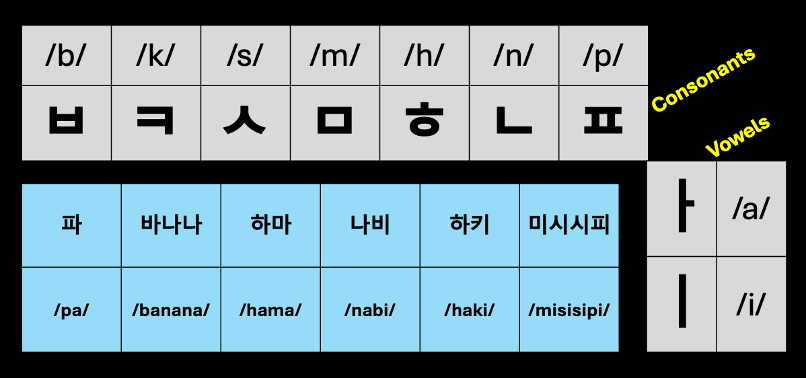
Have you noticed that, with some words (banana, hockey, Mississippi), you were immediately able to understand their meanings simply by successfully decoding the written letters (i.e., pronouncing the word correctly)? These are words of foreign origin that are actually used as a regular part of Korean vocabulary. By contrast, with some other words (파=green onion, 나비=butterfly, 하마=hippopotamus), it may not have felt like successful reading even after decoding the written letters correctly. That would be an accurate assessment because decoding is not the same as reading. In other words, if you did not already know these words in Korean, no meaning could be retrieved from your mind to be matched with the pronunciation that you correctly figured out by decoding the written letters.
See the reading formula according to the Simple View of Reading (Gough & Tunmer, 1986) in Figure 3. In this view, reading (R) is the product (in the mathematical sense of the word) of decoding (D) and comprehension (C). For example, even after correctly decoding the Korean word 하마 as /hama/ (D = 1), if you did not already know this Korean word, reading did not occur (R = 0) because there was no comprehension of its meaning (C = 0). Figure 3 shows three extreme scenarios of the formula. Once you decode the word banana, you also understand its meaning because the word is in your spoken language. Based on the letter-to-sound key for only a few consonants and vowels in Korean, if you are not able to decode the word Halloween written in Korean, you do not understand the written word although it is in your spoken language. Finally, even though you might be able to decode the word rain based on the provided letter-to-sound key, if you do not already know this word in Korean, no comprehension occurs.
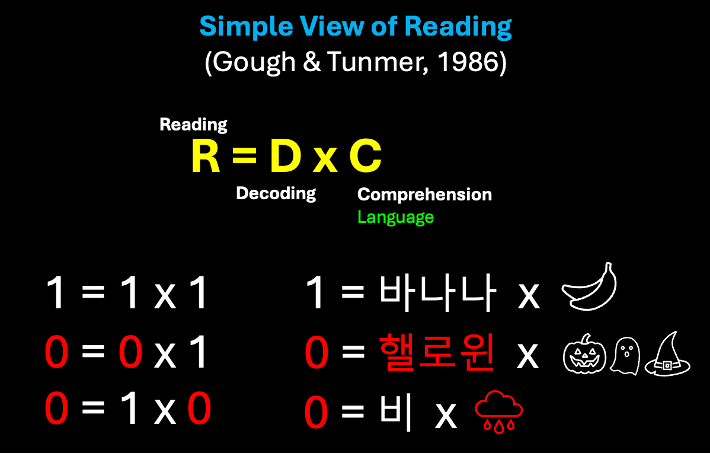
Successful reading, therefore, requires a strong foundation of oral language proficiency. When a learner possesses a sizable number of words in their oral language, decoding written forms of those words will automatically become a reading experience for them. In the opposite scenario, in which a learner successfully decodes written words only to realize that they do not know the meanings, and when this scenario occurs frequently, the concept of reading can become both meaningless and frustrating to them. Although this is true for both first language (L1) and second language (L2) readers, “the extent of prior oral language knowledge is one of some significant differences between the development of early literacy in L1 and L2” (Woore, 2022, p. 176). Research has further shown that the difference between L1 and L2 readers is more profound in their comprehension and vocabulary than in their decoding skills (Goldenberg, 2020, p. 136). Therefore, supporting the development of oral language proficiency for ELs cannot be emphasized too much. The same applies to supporting older learners’ development of oral language proficiency (Goldenberg, 2020, p. 137). We can then assume that, for students with limited or interrupted formal education (SLIFE) as well, developing oral language proficiency takes a priority in their preparation for learning to read in English.
How does all this fit into the five pillars of reading instruction?
What is commonly known as the science of reading is the culmination of a huge body of scientific research in various disciplines; yet, a particular misconception seems to misrepresent reading instruction based on the science of reading. As we saw earlier in the titles of newspaper articles for a general audience, phonics is usually highlighted as the main characteristics of reading instruction based on the science of reading. Even a quick glance at the five pillars, as recommended by the National Reading Panel (2000), would clearly indicate that it is not the case. As we can see in Figure 4a, phonics is only one of five equally important pillars of early literacy and reading instruction. Similarly, Figure 4b shows how these and other associated elements are incorporated into reading skills in what is called the Reading Rope (Scarborough, 2001).
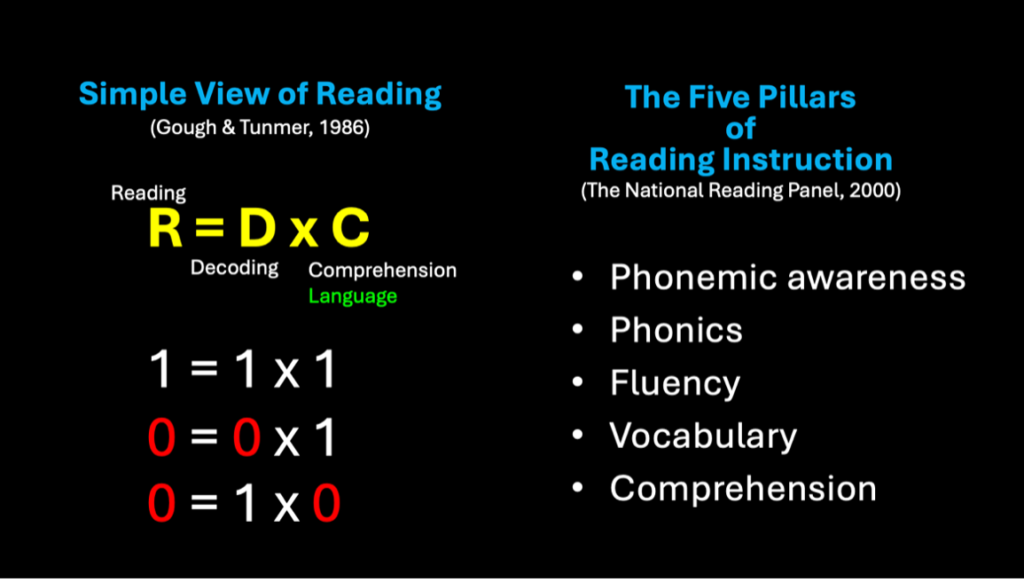
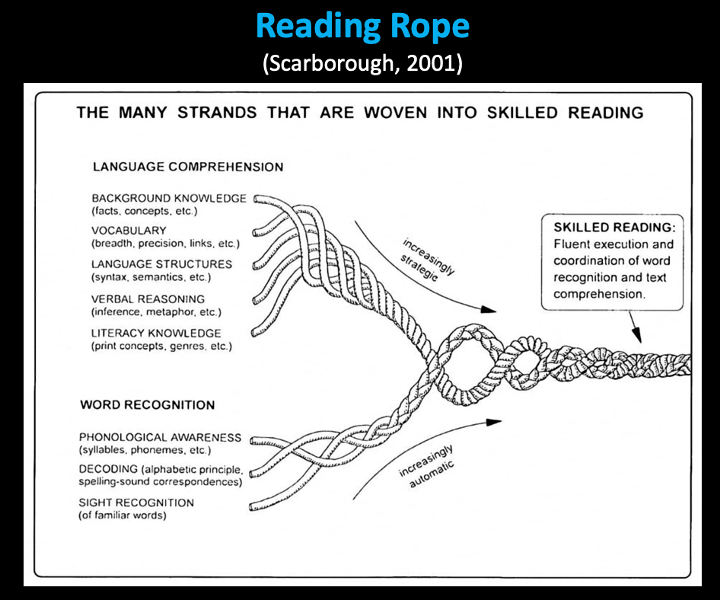
Figure 4a also shows how the five pillars correspond to the elements of the Simple View of Reading that we saw earlier in this paper. For the reading process to begin, figuring out the pronunciation of the words by decoding the written letters into corresponding phonemes is necessary (the pillars of phonemic awareness and phonics). Through practice, learners can demonstrate automaticity in decoding written words (the fluency pillar) as we saw in the Stroop task examples. As shown in the examples of Korean words, however, if the learner does not already know what the words mean as part of their oral language proficiency, even successful decoding does not lead to successful reading. Therefore, decoding is not sufficient (Gough & Tunmer, 1986, p. 7). Reading will fail without the pillars of vocabulary and comprehension.
Vocabulary knowledge includes three major aspects (form, meaning, and use), each of which includes more detailed aspects such as, to name just a few, knowing the form receptively vs. productively, knowing the core meaning vs. extended meaning, or knowing grammatical or pragmatic constraints on use (Nation, 2023). Comprehension includes spoken language comprehension (i.e., listening comprehension) as well as written language comprehension (i.e., reading comprehension). Most EL teachers already spend enormous amounts of time and energy helping learners improve their vocabulary and comprehension of spoken language as these are the key learning activities for ELs. In other words, most of EL teachers’ pedagogy naturally fits into instructional approaches based on the science of reading. At the same time, it is important for EL teachers to understand how to teach phonemic awareness and phonics in a systematic and research-based manner because they have not been emphasized in previously common reading curricula such as those based on balanced literacy (Calkins & TCRWP Colleagues, 2019). Therefore, it is important to discuss how EL teachers’ practice should and should not be impacted by the new requirement of teaching literacy based on the science of reading.
How can EL teachers’ current practice align with the science of reading framework?
As mentioned above, most EL teachers already do a good job with some pillars of reading instruction such as vocabulary and comprehension, and they should continue to support learners in those areas of language development. To address the other pillars more effectively, it is necessary to have an informed framework that helps to translate the five pillars into concrete instructional methods. Below, we will examine key concepts that will help establish a systematic approach to teaching the five pillars of the science of reading.
What should be learned/taught implicitly or explicitly?
Some aspects of language skills can be acquired more effectively through explicit learning/teaching (VanPatten & Smith, 2022). Explicit learning/teaching involves conscious mental or cognitive operations such as thinking about something, talking about something, or analyzing/comparing/evaluating something (Hulstijn, 2005). In other words, explicit learning/teaching deals with the target of learning through directly addressing it by means of mental or communicative acts. In everyday classroom settings, both learners and teachers are all too familiar with this kind of learning and teaching. For example, in an EL class, students might engage in a task of categorizing adjectives according to their positive vs. negative meanings. The explicit nature of the categorizing task encourages students to tap into their existing knowledge of those adjectives and the various contexts in which those adjectives are used. When this kind of explicit task is performed with peers, students can enrich one another’s learning experience. The teacher can also enrich students’ learning even further by meaningfully engaging in this kind of explicit tasks. For example, young learners’ categorization of adjectives might have a gap that can be filled effectively with the teacher’s input. Explicit learning and teaching can look more like learners and teachers interacting together towards a common goal (in this example, the goal of learning about the adjectives more deeply).
Some aspects of language skills require that learners engage in implicit tasks specifically designed for the learning of those skills (Nation, 2023, pp. 63-65). In contrast to some common explicit tasks described above, implicit learning is not directly accessible to conscious manipulation (Reber et al., 1999, p. 504). Instead, learning happens as an outcome of performing certain tasks, in most cases, repeatedly. Depending on the first language background, English learners may have difficulty with different minimal pairs such as light vs. right (for some students with Japanese as their L1) or so vs. show (for some students with Nepalese as their L1) to illustrate a few examples. In most cases, these students may have difficulty in both detecting the minimal pairs when they hear them and producing those minimal pairs in their own speech. To acquire the skills to accurately detect the difference and to produce the sounds correctly, students need more than thinking about or talking about these different sounds (i.e., explicit learning) and more than their teacher’s explanation (i.e., explicit teaching). Instead, students need to do what athletes do: physical training, on an individual level, to turn their body into a system that can perform a certain task accurately. When a figure skater learns to do the triple Axel jump, for example, it is the outcome of the skater’s body repeatedly engaging in a series of movements until the entire sequence is automatized with accuracy and fluency. In a similar fashion, learning by doing it can be the only way for some language skills such as getting the form right. The teacher’s job, then, would be to design proper tasks for that purpose.
Why is it important to distinguish between implicit and explicit learning/teaching as applied to literacy education based on the science of reading? In the process of learning to read (i.e., decoding and comprehension), some steps require the teacher’s direct and explicit instruction whereas some other steps require the learner’s engagement in implicit tasks for the purpose of learning by doing it. To discuss this, the following section will present the Phase Theory of Development in the process of learning to read and spell words (Ehri, 2015, 2022).
What are the phases of development in learning to read and spell words?
The Phase Theory of Development describes children’s knowledge about the alphabet and their corresponding ability to decode and comprehend written words progressing through four phases: the pre-alphabetic, partial alphabetic, full alphabetic, and consolidated alphabetic phases (Ehri, 2015). Table 1 presents some highlights of these phases. Please refer to Table 20.1 in Ehri (2015, p. 300) for more detail.
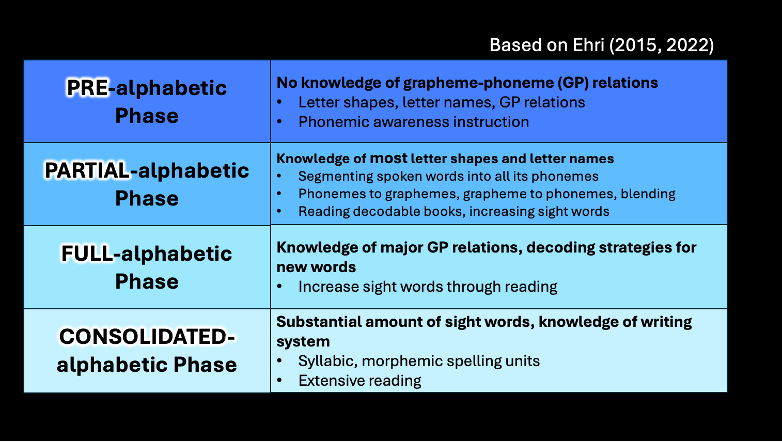
At each phase, learners exhibit different kinds of understanding about the relationship between written language and spoken language. Therefore, instructional methods will need to vary according to what learners need to learn in their current phase. For example, learners in the pre-alphabetic phase need to learn, among other things about the alphabet, what sound is represented by what letter. The relationship between a letter and the sound it represents is arbitrary in that different writing systems do it differently. For example, the capital letter L in English may look like the Korean consonant ㄴ, but they each represent a different sound: L for /l/ in English vs. ㄴ for /n/ in Korean. What does this mean for teaching and learning? Explicit and direct teaching is necessary and effective for students to learn this kind of arbitrary relationship between letters and sounds. This is the basis for the importance of phonics at this level of literacy development. Let’s use Korean as an example again. If you are learning to read in Korean for the first time, it would be most effective to be told explicitly that the letter ㄴ represents the sound /n/ as in 바나나 (banana). I assume that, in the Korean lesson earlier, you found the letter-to-sound key (i.e., explicit presentation of the information) useful and helpful. Excessive guesswork or games to initially figure out the relationship between a letter and its sound can only delay the learning process. Instead, by teaching it directly and explicitly, teachers can quickly prepare the learners to begin necessary practice to become accurate and fluent in recognizing the relationship between a letter and its sound.
By contrast, if the goal is to help learners become fluent in either recognizing written words or fluent in spelling words correctly, teachers need to design tasks that are implicit in nature so that learners develop fluency in these skills by doing it rather than through any explicit approaches such as thinking about them, talking about them, hearing about them, etc. What would be an example of an implicit task designed to help learners become fluent in recognizing and spelling words? The answer is clear if we focus on learning by doing it as the main feature of implicit learning. Any activity or task would work that inherently incorporates the act of recognizing written words repeatedly and the act of spelling words repeatedly. Figure 5 shows a simple activity that I call Word Quilt, in which students are given a simple grid to be filled with words they are practicing to spell. It is just like a coloring book. To complete this simple task, learners repeat spelling the same words multiple times. When a simple task like this is completed, the target skill (i.e., spelling the words) becomes automatized with accuracy and fluency. It is the built-in repetition of the target skill that creates a condition for learning by doing it.
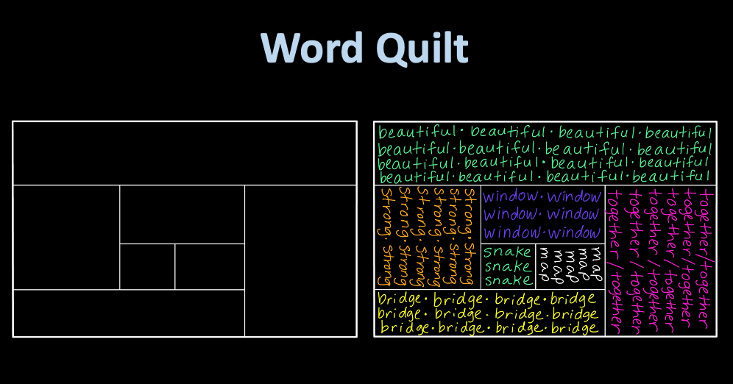
Figure 6 is a variation of a crossword puzzle or bingo game. First, each student receives a blank grid. Next, they are told to write a word that they just learned to spell a number of times anywhere in the grid. For example, the teacher might show the word cat on the board and say, “Write this word five times anywhere in your grid.” Repeat this step with different words. Then, students are told to fill in any blank cells with random letters so that the entire grid is filled with letters. (Note: In the example shown in Figure 6, words are written in different colors for illustration purposes here only.) Finally, students swap their self-made puzzles and search for the words that the teacher calls out. The teacher might say, “Find and circle all five of the word cat.” The beauty of this type of activity lies in the simple fact that it is the students who do all the work: creating the puzzle (practicing spelling the words multiple times in the process) and solving the puzzle (practicing recognizing written words multiple times in a version created by their peers). From start to finish, students are engaged in a task specifically designed to become good at recognizing written words and spelling words simply by doing it (i.e., implicit learning). The example shown here is for young learners or learners at the beginning level, but it can be modified to match the proficiency level of the learners by changing the size of the grid. Research shows that being able to spell words helps remembering words and reading (Ehri, 2005, pp. 177-178; Ehri, 2015, p. 299). If the goal is to help learners become good at spelling, then teachers should design activities that help learners become good at it by doing it.
Most EL teachers already have a good repertoire of language learning activities, which could be classified as implicit or explicit in their nature. The point being emphasized is that these different ways of learning/teaching should be suitably matched with different aspects of language skills and learning goals. The space in this article is limited to discuss how to match implicit vs. explicit learning/teaching with all different aspects of language skills. Readers are recommended to explore these concepts further in published research (Nation, 2023; VanPatten & Smith, 2022).
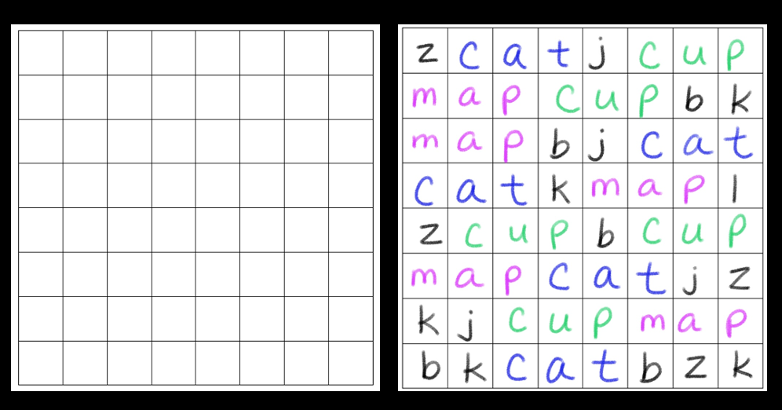
What does the science of reading mean for EL teachers’ practice?
As we saw in the five pillars of reading instruction, most of what EL teachers do in their teaching can be described as fulfilling the goals of some pillars such as developing vocabulary and comprehension skills with an emphasis on proficiency in spoken language. It is particularly important to acknowledge this because of the unfortunate misunderstanding about the science of reading; namely, incorrectly interpreting it to be only and all about phonics. In fact, teaching phonemic awareness or phonics would not even work without a good foundation of oral language proficiency and vocabulary (Woore, 2022). As stated by Goldenberg (2020), “EL’s proficiency in English enhances reading. When not sufficiently proficient, reading will be inefficient affecting achievement and motivation” (p. 136). Therefore, an incorrect understanding of what the science of reading is all about should not deter EL teachers’ continuing effort to help learners develop proficiency in oral language skills.
One of the reasons for incorrectly believing that the science of reading is only and all about phonics stems from the distinction between implicit and explicit learning/teaching. In approaches to reading instruction that are at odds with the science of reading approach, such as reading curricula based on what is known as balanced literacy (Calkins & TCRWP Colleagues, 2019), explicit teaching of the letter-to-sound relationships is discouraged, if not completely banned, and students are unnecessarily and unfairly subjected to guessing what could simply be taught explicitly. By contrast, pedagogical approaches based on the science of reading, such as structured literacy (MDE, 2023), emphasize explicit and systematic instruction when it comes to developing foundational skills for reading including phonics for decoding skills. In this paper, we examined the importance of matching implicit vs. explicit learning with different aspects of language skills. Because most EL teachers already have various teaching strategies and approaches in their tool kits, it would be helpful to align them according to the distinction between implicit and explicit learning/teaching and make necessary adjustments accordingly.
Finally, and again, the space is too limited in this article to address all relevant issues of instructional approaches based on the science of reading. Although a large body of published research is available on this topic, if you are interested in learning more about fundamental concepts of the science of reading as applied to instruction, the following studies are recommended for starters: Ehri (2015, 2022), Goldenberg (2013, 2020), Goldberg & Goldenberg (2022), Gonzalez-Frey & Ehri (2021), Gough & Tunmer (1986), Saunders, Goldenberg, & Marcelletti (2013), Seidenberg (2013), and Seidenberg, Borkenhagen, & Kearns (2020). (Note: There are two many published studies by Ehri and colleagues to be listed here, but a simple search under the name Ehri may yield studies that could be relevant in your teaching context.) As emphasized by Goldenberg (2020), for ELs “the science of reading still applies, but it is not enough” (p. 133) and “we must redouble, and redouble again, efforts to promote and accelerate English language development for ELs” (p. 141). I hope that this article has appropriately acknowledged most EL teachers’ tireless effort in doing that.
References
Calkins, L., & TCRWP Colleagues. (2019). Units of study in phonics. Heinemann.
Dudley, K. (2023). “Science of reading” research for educators of emergent bilinguals in kindergarten. MinneTESOL Journal, 39(2). https://minnetesoljournal.org/science-of-reading-research-for-educators-of-emergent-bilinguals-in-kindergarten/
Ehri, L. C. (2005). Learning to read words: Theory, findings, and issues. Scientific Studies of Reading, 9(2), 167-188. https://doi.org/10.1207/s1532799xssr0902_4
Ehri, L. C. (2015). How children learn to read words. In A. Pollatsek & R. Treiman (Eds.), The Oxford handbook of reading (pp. 293-310). Oxford University Press. https://doi.org/10.1093/oxfordhb/9780199324576.013.19
Ehri, L. C. (2022). What teachers need to know and do to teach letter-sounds, phonemic awareness, word reading and phonics. The Reading Teacher, 76(1), 53-61. https://doi.org/10.1002/trtr.2095
Goldenberg, C. (2013). Unlocking the research on English learners: What we know and don’t yet know about effective instruction. American Educator, 37(2), 4-11, & 38.
Goldenberg, C. (2020). Reading wars, reading science, and English learners. Reading Research Quarterly, 55(S1), 131-144. https://doi.org/10.1002/rrq.340
Goldberg, M., & Goldenberg, C. (2022). Lessons learned? Reading wars, reading first, and a way forward. The Reading Teacher, 75(5), 621-630. https://doi.org/10.1002/trtr.2079
Gonzalez-Frey, S. M., & Ehri, L. C. (2021). Connected phonation is more effective than segmented phonation for teaching beginning readers to decode unfamiliar words. Scientific Studies of Reading, 25(3), 272-285. https://doi.org/10.1080/10888438.2020.1776290
Gough, P. B., & Tunmer, W. E. (1986). Decoding, reading, and reading disability. Remedial and Special Education, 7(1), 6-10. https://doi.org/10.1177/074193258600700104
Guttentag, R., & Haith, M. (1978). Automatic processing as a function of age and reading ability. Child Development, 49(3), 707-716.
Hulstijn, J. (2005). Theoretical and empirical issues in the study of implicit and explicit second language learning. Studies in Second Language Acquisition, 27(2), 129-140. https://doi.org/10.1017/S0272263105050084
Mervosh, S. (2023, January 3). In Memphis, the phonics movement comes to high school: Literacy lessons are embedded in every academic class. Even in biology. The New York Times. https://www.nytimes.com/2022/12/25/us/reading-literacy-memphis-tennessee.html
Minnesota Department of Education. (2023). Principles of structured literacy. COMPASS Summer Institute document.
Nation, I. S. P. (2023). Learning vocabulary in another language. Cambridge University Press.
National Reading Panel. (2000). Teaching children to read. National Institute of Child Health and Human Development.
Reber, A. S., Allen, R., & Reber, P. J. (1999). Implicit versus explicit learning. In R. J. Sternberg, (Ed.), The nature of cognition (pp. 475-513). MIT Press.
Saunders, W., Goldenberg, C., & Marcelletti, D. (2013). Guidelines for English language development instruction. American Educator, 37(2), 13-25, & 38-39.
Scarborough, H. S. (2001). Connecting early language and literacy to later reading (dis)abilities: Evidence, theory, and practice. In S. Neuman & D. Dickinson (Eds.), Handbook for research in early literacy (pp. 97-110). Guilford Press.
Seidenberg, M. S. (2013). The science of reading and its educational implications. Language Learning and Development, 9(4), 331-360. https://doi.org/10.1080/15475441.2013.812017
Seidenberg, M. S., Borkenhagen, M. C., & Kearns, D. M. (2020). Lost in translation? Challenges in connecting reading science and educational practice. Reading Research Quarterly, 55(S1), 119-130. https://doi.org/10.31234/osf.io/sq4fr
Stroop, J. R. (1992). Studies of interference in serial verbal reactions. Journal of Experimental Psychology: General, 121(1), 15-23. https://doi.org/10.1037/0096-3445.121.1.15 (Original work published in 1935.)
VanPatten, B., & Smith, M. (2022). Explicit and implicit learning in second language acquisition. Cambridge University Press.
Woore, R. (2022). What can second language acquisition research tell us about the phonics ‘pillar’? The Language Learning Journal, 50(2), S172-185. https://doi.org/10.1080/09571736.2022.2045683
Zimmer, A., Gonen, Y., The City, & Zimmerman, A. (2022, May 12). In a seismic shift, NYC to mandate elementary schools use phonics-based curriculum. Chalkbeat. https://www.chalkbeat.org/newyork/2022/5/12/23069423/nyc-schools-dyslexia-phonics-curriculum-eric-adams/






